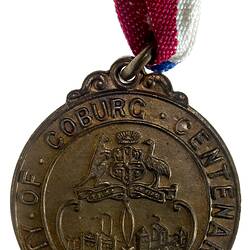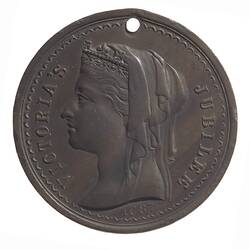Coburg is a residential suburb 8 km north of Melbourne. The Municipality of Coburg, which operated from 1874 to 1994, was bordered on the south by Brunswick and on the west and east by the Moonee Ponds and the Merri Creek valleys.
In 1837 Robert Hoddle surveyed the Coburg area between the two creeks, subdividing it into allotments of between 53 ha. And 287 ha. A village reserve was marked out where the former Pentridge Gaol and Coburg cemetery are now located. Among the first purchasers were John Pascoe Fawkner, who had two lots, totalling 517 ha. A road to Sydney was marked out along the western side of the village reserve.
Some allotments near the Sydney Road were subdivided into small farms, and the village reserve was named Pentridge in 1840. In addition to the Pentridge village there were villages called Bolingbroke to the west and Newlands to the north. A Catholic church opened around 1844, the Wesleyans got into the act in 1849 and the Anglicans followed, erecting a church right next door. Pentridge's first school opened in 1850 in the Anglican church, and others soon followed.
The upstanding young community was faced with a challenge, however. In 1850 the Port Phillip authorities chose Pentridge as a site for a penitentiary, considering the area sufficiently remote from Melbourne and requiring road-making materials, readily available in the bluestone deposits in the area, the quarrying of which would to keep the prisoners employed.
In 1859 the Pentridge District Road Board was formed, changing its name to Coburg a decade later in 1869, when residents asked to dissociate their place name from the gaol. The name Coburg was chosen in deference to Prince Alfred, Duke of Saxe Coburg and Duke of Edinburgh, who had recently been Australia's first royal visitor. Subdivision continued in the area, with market gardens near the Merri Creek growing hay for Melbourne's increasing numbers of horses. Sydney Road attracted numerous hotels and commercial premises. Friendly societies were formed as the community developed. By 1870 there were the village and surrounding area and 645 in the gaol (including warders and their families).
Coburg was proclaimed a shire on 24 December 1874. In 1884 the railway line from Melbourne to Coburg was opened; a tram service to Moreland, south of Coburg village, opened three years later. The transport links provoked a boom in residential land subdivisions, predominantly in the south of the shire. Residents found work on farms or in neighboring Brunswick's factories, and Coburg was considered an attractive suburb with charming valleys.
In 1887 the Shire of Coburg issued a medal to commemorate the jubilee of Queen Victoria (NU 20475). It names Cr Arthur Cherry, JP, as Shire President.
In January 1905 Coburg was proclaimed a borough, in evidence of the four-fold growth in its population since 1880, and on 18 September 1912 it became a town. In 1914 the Brunswick and Coburg Tramways Trust was created, replacing the horse-drawn tram service. Electric trams ran along Sydney Road to Coburg North by 1916. Sporting and swimming facilities were provided in that decade along with the laying out of some parklands. The Coburg lake and parkland became a popular recreational area until the 1930s.
By the 1920s development extended about one kilometre either side of Sydney Road, but the War Service Commission encouraged servicemen to settle and build on Coburg's relatively cheap land. Local industries grew, including the Lincoln Mills (clothing), Invicta Manufacturing, Dawn Vices, bottle, plaster and timber-milling factories.
New housing westwards was followed by the Coburg West primary school (1917) and eastwards with another school in 1926. Coburg was proclaimed a city on 1 April 1922.
Coburg was named as a city on a medal issued to commemorate the centenary of Victoria (NU 33149).
After World War II many factories were located on Gaffney Street, maintaining local employment. Textiles and garments were the main outputs, but paint, chemicals and engineering goods were significant. Coburg technical school was opened in 1954, five years after the College of Textiles opened. A teachers' college was opened in 1959, later becoming a campus of the Royal Melbourne Institute of Technology.
Between 1947 and 1981 the proportions of Coburg municipality's residents born overseas increased from 9% to 34%. Over one-third of them were Italian, and one-eighth were Greek. There are several Catholic schools and churches in the municipality. Later immigrants from Middle Eastern countries opened two Islamic colleges and a mosque in Coburg.
On 22 June 1994 part of the City of Coburg and the Cities of Preston and Northcote united to form the Darebin City Council. The remainder of Coburg, the City of Brunswick and part of the City of Broadmeadows united to form the Moreland City Council on the same day.
In the later twentieth century Coburg was affected by tariff reductions for garments and textiles, with the Lincoln Mills closing in 1980 (although later used by smaller firms); in 1981 the Government Clothing Factory was sold. On 1 May 1997 Pentridge Gaol was closed.
References:
Municipal Association of Victoria website http://www.mav.asn.au, accessed 06/01/2004
Australian Places website, Monash University, http://arts.monash.edu/ncas/multimedia/gazetteer/list/coburg.html, accessed 06/01/2004.
More Information
-
Keywords
-
Localities
-
Authors
-
Article types






